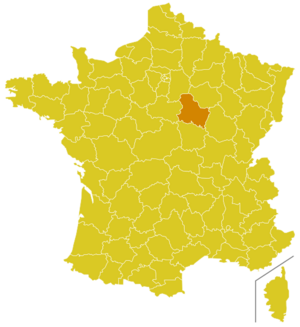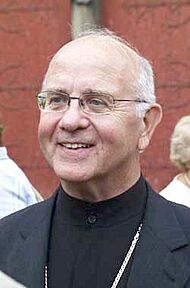Roman Catholic Archdiocese of Sens facts for kids
Quick facts for kids Archdiocese of Sens and AuxerreArchidioecesis Senonensis et Antissiodorensis Archidiocèse de Sens et Auxerre |
|
|---|---|

Sens Cathedral
|
|
| Location | |
| Country | |
| Ecclesiastical province | Dijon |
| Metropolitan | Archdiocese of Dijon |
| Statistics | |
| Area | 7,460 km2 (2,880 sq mi) |
| Population - Total - Catholics |
(as of 2014) 342,724 209,600 (61.2%) |
| Information | |
| Denomination | Catholic |
| Sui iuris church | Latin Church |
| Rite | Roman Rite |
| Established | 1st Century |
| Cathedral | Cathedral of St. Stephen in Sens |
| Patron saint | St. Savinian and St. Potentian |
| Current leadership | |
| Pope | Francis |
| Archbishop | Vacant |
| Metropolitan Archbishop | Antoine Hérouard |
| Emeritus Bishops |
|
| Map | |
 |
|
| Website | |
| Website of the Archdiocese | |
The Archdiocese of Sens and Auxerre is a special area of the Catholic Church in France. It is led by an archbishop. This archdiocese covers the department of Yonne, which is in the region of Bourgogne. It was started a very long time ago, possibly in the first century.
For many years, the Archbishop of Sens was very important. They even held the title "Primate of the Gauls and Germania." This meant they were seen as a top leader in the Church for a large area. Until 1622, the Archdiocese of Sens had seven other dioceses (church areas) that reported to it. These included Chartres, Auxerre, Meaux, Paris, Orléans, Nevers and Troyes.
However, things changed on December 8, 2002. The Archdiocese of Sens-Auxerre became less powerful. It is now part of the Archdiocese of Dijon, which is the main church center for the Burgundy region. Because of this change, the Archbishop of Sens-Auxerre no longer has the special privilege of wearing the pallium, a special cloth worn by archbishops.
Contents
History of the Archdiocese
Until the French Revolution, the Archbishop of Sens was also a local leader called the Viscount of Sens. In 1622, Paris became a major church center, and some dioceses like Chartres, Orléans, and Meaux no longer reported to Sens.
The church organization changed a lot after the Napoleonic Concordat in 1802. This agreement combined the dioceses of Sens and Auxerre with the Roman Catholic Diocese of Troyes. For a while, the Archbishop of Paris was given the honorary title of Archbishop of Sens, but without any real power over Sens.
Later, in 1817, the Archdiocese of Sens and the Diocese of Auxerre were brought back. But this did not last long. In 1821, the Diocese of Auxerre was removed again. The Archdiocese of Sens then covered the Yonne department and included the dioceses of Troyes, Nevers, and Moulins. In 1823, the Archbishop of Sens was also given the title of Bishop of Auxerre.
The Archbishop of Sens-Auxerre used to live in Sens until the 1920s. Now, they live in Auxerre, but their main church, called the cathedra (or seat), is still at Sens Cathedral.
The story of the church in Sens begins with Savinian and Potentian. These two saints are believed to have founded the church there. Early records don't mention them, but by the 9th century, people started to honor them. Their remains were moved to a church in 847, which made them more famous. Later, a monk named Odoranne wrote about them around 1045.
An old story, written between 1046 and 1079, says that Savinian and Potentian, along with their friends, helped spread Christianity in other cities like Orléans, Chartres, and Troyes. While the Christian faith probably wasn't preached in Sens as early as the 2nd century, records show that by 475, Sens already had its 13th bishop. This suggests the church leadership started in the late 3rd or early 4th century.
Important Leaders (Bishops and Archbishops)
Before 1000 AD
Here are some important bishops of Sens from the early centuries:
- St. Severinus (around 344): He was at an important church meeting called the Council of Sardica.
- St. Ursicinus (356–387): He was sent away to Phrygia because of a religious disagreement called Arianism. When he returned, he started a monastery in Sens.
- St. Heraclius (487–515): He founded a monastery dedicated to St. John the Evangelist in Sens.
- St. Leo (530–541): He sent St. Aspais to teach Christianity in Melun.
- St. Lupus (around 609–623): He was a bishop who was allowed by the king to make coins in his area. He also founded a monastery.
- St. Vulfran (692–695): He left his position in Sens to spread Christianity in Frisia.
- St. Ebbo (before 711): He was a leader who helped defend Sens from an attack by the Saracens in 731.
- Magnus (before 802): He was a chaplain for Charlemagne, a famous emperor. He wrote a guide for laws.
- Jeremias (died 828): He was an ambassador for Emperor Louis the Pious in Rome.
- Vénilon (837–865): He crowned Charles the Bald as king in 843. He was later accused of betrayal, and his name is linked to the traitor Ganelon in the famous story Chanson de Roland.
- Ansegisus (871–883): He was named the "primate" (top leader) for France and Germany by Pope John VIII. This was a very important title. During his time, a history of the archdiocese was written.
- Walter (887–923): He crowned several French kings, including Eudes and Rudolph of France. He also gave a valuable old prayer book to the church of Sens.
- Sevinus (976–999): He was involved in a church council and had disagreements with King Hugh Capet.
1000–1200
- Gelduinus (1032–1049): He was removed from his position for buying church offices, which is called simony.
- Richerius (1062–1096): During his time, the Pope gave the special "primatial authority" (top leadership) to the Archbishop of Lyon instead of Sens.
- Henri Sanglier (1122–1142): He led a council that criticized some ideas of Abelard, a famous thinker.
- Hugues de Toucy (1142–1168): He crowned Constance, the wife of King Louis VII. Also, Pope Alexander III stayed in Sens for 18 months during his time, making Sens a very important place for the Church.
- Guillaume aux Blanches Mains (1168–1176): He was related to the French king and the English king. He placed England under an interdict (a church punishment) in 1172.
- Michael of Corbeil (1194–1199): He fought against a group called the Publicans, who had different religious beliefs.
1200–1500
- Peter of Corbeil (1200–1222): He was a teacher of theology to Pope Innocent III.
- Pierre Roger (1329–1330): He later became Pope Clement VI.
- Guillaume de Brosse (1330–1338): He put up a statue of King Philip VI at the Sens cathedral to remember a victory.
- Guillaume de Melun (1344–1375): He was captured by the English along with King John II at the Battle of Poitiers in 1356.
- Jean de Montaigu (1406–1415): He was killed at the famous battle of Agincourt.
- Henri de Savoisy (1416–1422): He blessed the marriage of Henry V of England and Catherine of France in 1420.
- Tristan de Salazar (1475–1519): He made the first alliance treaty between France and Switzerland.
1500–1800
- Antoine Duprat (1525–1535): He became a cardinal in 1527.
- Louis de Lorraine (1560–1562): He was known as Cardinal de Guise.
- Nicolas de Pellevé (1562–1592): He became a cardinal in 1570.
- Cardinal du Perron (1606–1618): A very important cardinal.
- Jean-Joseph Languet de Gergy (1730–1753): He wrote the first biography of Marie Alacoque and was a member of the French Academy.
- Paul d'Albert de Luynes (1753–1788): He became Cardinal de Luynes and was also a member of the French Academy.
- Loménie de Brienne (1788–1793): He was a minister for King Louis XVI and a cardinal. During the French Revolution, he faced many difficulties and died in prison.
1800–present
- Anne, Cardinal de la Fare (1821–1829)
- Jean-Joseph-Marie-Victoire de Cosnac (1829–1843)
- Mellon de Jolly (1843–1867)
- Victor-Félix Bernadou (1867–1891)
- Pierre-Marie-Etienne-Gustave Ardin (1892–1911)
- Jean-Victor-Emile Chesnelong (1912–1931)
- Maurice Feltin (1932–1935): He later became the Archbishop of Bordeaux.
- Frédéric Edouard Camille Lamy (1936–1962)
- René-Louis-Marie Stourm (1962–1977)
- Eugène-Marie Ernoult (1977–1990)
- Gérard Denis Auguste Defois (1990–1995): He later became the Archbishop of Reims.
- Georges Edmond Robert Gilson (1996–2004)
- Yves François Patenôtre (2004–2015)
- Hervé Giraud (2015–2024)
Church Councils in Sens
Many important church meetings, called councils, were held in Sens between the years 600 and 1485.
- One early council dealt with a disagreement about the date of Easter.
- The Council of 1140 decided against some of the ideas written by Abelard, a famous philosopher.
- The Council of 1198 focused on a religious group called the Manichaean sect of the Poplicani.


